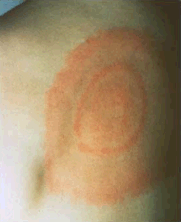The recent news of the Lyme Disease being found in the Rouge River Valley has a lot of people worried.
We’ve heard how awful this disease can be for people – what does it mean for our pets?
What is Lyme Disease?
Lyme is caused by a bacteria called Borrelia, and it is spread by tick bites. A tick that is feeding on blood does not want the blood to clot, so it pumps in anti-clotting saliva to keep its meal coming.
This means that any bacteria that is in the tick will end up in its involuntary blood donor.
A tick has to be feeding for about 48 hours to transmit enough bacteria to cause infection.
There are two peak seasons for tick bites: Spring (nymphs) and Fall (adults).
Larvae, tiny ticks that only have 6 legs, hatch in the spring and feed on tiny creatures like mice. In that first year, they are no threat to anything larger – they stay tiny and then go dormant over the winter.
The following spring, the larvae molt to become 8-legged nymphs. If they picked up bacteria from a mouse, they can transmit it now to larger animals, which could include dogs or humans. If they did not, they may pick it up now from the animals they feed on.
In the fall, those nymphs molt again to become adults, and another feeding cycle starts.
So what happens to an infected host?
The path that Lyme disease takes is very different in pets compared to in humans.
- In humans, 80% of those bitten get a “bull’s eye” rash and/or flu-like symptoms.
Don’t assume that is there is no rash, there is not infection: less than 30% of Lyme patients recall a rash or noticing that a tick bit them. In the next few weeks, joint pain develops; some people go on to have nerve and heart problems.
- Dogs, in the same time period after an infecting bite, show nothing at all. In the less than 20% of infected dogs that do show joint pain and flu-like symptoms, it does not happen until 2-5 months after the bite. And, dogs do not get nerve or heart problems. A small number of infected dogs go on to develop kidney failure (<2%). It is not that the bacteria damage the kidneys directly; it is the immune system’s ongoing response to infection that produces proteins that clog up the kidneys’ filter units. The dogs that get this kidney problem may not ever have had the lameness/flu symptoms.
- Cats can get infected by Borrelia; we know this, because we can find that they have made blood antibodies to the bacteria. Cats do not seem to develop any symptoms from being infected with Borrelia.
What can we do about it?
Tick control
- Ticks need to feed for about 48 hours to transmit the infection. Flea-tick collars can prevent them from attaching in the first place; preventive medications such as Revolution cause them to drop off after only a couple of hours.
- Another good strategy is to inspect your dog after a walk in woods or tall grasses, and remove any ticks that have attached.
Vaccination
Vaccination can stop the bacteria getting in in the first place, but it can not help once the pet is already infected. The antibodies that the vaccine causes to be produced actually target a protein that the bacteria makes while it is still in the tick’s gut. When the tick sucks up blood full of antibodies, these gum up the bacteria and prevent their migration. Once the tick is into the host’s body, though, they change the protein they make; those antibodies won’t help anymore.
Antibiotics
Once there is a Borrelia infection, you will never truly get rid of it. Borrelia is a master of disguise: it changes its surface proteins and even its shape to evade the immune system’s notice, and goes into hiding down in tissues such as the joint cartilage.
So, we don’t use antibiotics to cure Lyme disease – just to take it down a notch. In dogs, we will use antibiotics if they are having symptoms (the joint pain and flu-like issues), or if they are starting to show kidney problems (if you decrease the number of bacteria, you can decrease the production of the proteins damaging the kidneys).
Monitoring
When we do the yearly blood test for heartworm, that is a good chance to check also for Lyme disease. Why do we want to know about it if a dog has no symptoms? A positive Lyme test is a heads up that we should be checking the urine every 6 months, so we can catch and treat the kidney problem as soon as possible.



